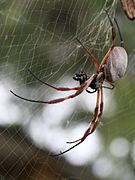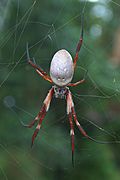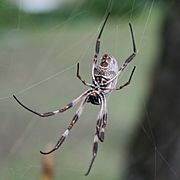Trichonephila edulis facts for kids
Quick facts for kids Trichonephila edulis |
|
|---|---|
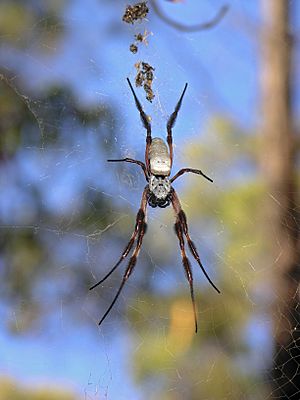 |
|
| A female Trichonephila edulis spider in Perth, Western Australia. | |
| Scientific classification | |
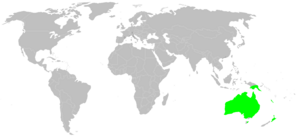 |
|
| Synonyms | |
|
Aranea edulis |
The Trichonephila edulis is a type of large spider. It belongs to the family of orb-weaver spiders. People often call it the Australian golden orb weaver. You can find this spider in Australia, in both warm and mild areas. It also lives in parts of New Guinea and New Caledonia.
These spiders can be very different in size. Female spiders can grow up to 40 millimeters long. That's about the size of a large paperclip! Males are much smaller, only about 7 millimeters long. The spider's body has two main parts. Its head and chest area, called the cephalothorax, is black with white patterns. Its belly, or abdomen, is usually gray to brown.
Contents
About the Golden Orb Weaver
The Trichonephila edulis spider is known for building very large webs. These webs can be about 1 meter wide. That's as wide as a doorway! The spider often adds a strong "barrier" web on one or both sides. This barrier helps protect the main web.
Life Cycle and Reproduction
These spiders usually mate and lay eggs from February to May. A female spider can lay many eggs. On average, she produces about 380 eggs in one go.
The Trichonephila edulis is closely related to another spider. This spider is called the Trichonephila plumipes, or tiger spider. The tiger spider is also common in Australia.
Where the Name Comes From
A scientist named Jacques Labillardière first found and named this spider. This happened in 1799. It was one of the first Australian spiders described by a European scientist. The first one was the Gasteracantha fornicata.
The name edulis comes from a Latin word. It means "edible," which means "can be eaten." Labillardière wrote that people in New Caledonia called this spider nougui. He named it Aranea edulis because the people there ate it.
Spiders as Food
Some people in certain parts of the world eat Trichonephila edulis spiders. In New Guinea, some related spiders are seen as a special food. People carefully pick them from their webs. Then, they lightly cook them over a fire.
Gallery


